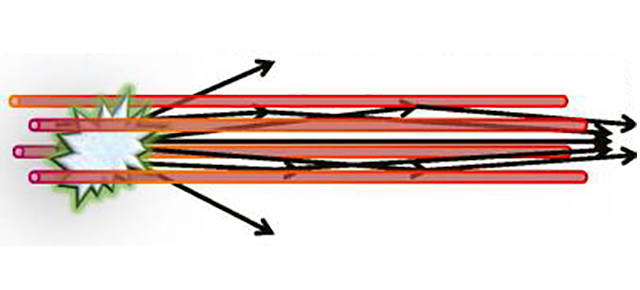Pulses of light are the absolute fastest way to transfer data (because nothing’s faster than light), but old school fibre optic cables can only go so many places. Scientists have a new idea: use high-powered lasers to make a column of low-density air that can carry a light signal just as well as a normal cable. Yes, fibre optics made of thin air.
Get ready to dust off your high-school physics knowledge. Dr. Howard Milchberg and his team at the University of Maryland found that very powerful laser blasts collapse the air around them into a narrow beam called a filament. These filaments of hot air then expand, opening up a tube of low density air. This hole has a lower refractive index than undisturbed air — in other words, it’s like a mirrored tube.
In a paper published today, Dr. Milchberg and team showed that four such lasers fired in a square arrangement create a cage of low-density air columns. A fifth laser beam shot down the middle will stay trapped between these four columns (show in red above), since the low density air reflects light. In other words, the four mirrored tubes trap the laser beam in the centre, focusing it on its target instead of allowing it to scatter in the air, as diagrammed with black arrows in the above illustration.
All of this happens astonishingly quickly. The filaments themselves disappear after just one-trillionth of a second, but the low-density holes, the reflective tubes that form the boundary of this air-cable, takes a billion times longer to appear. All told, the “air cable” created by the laser pulses survives for a few milliseconds — plenty of time to blast a data beam through. As Dr. Milchberg said in the announcement of the findings, “milliseconds is infinity” when it comes to laser transmission.
In testing, Dr. Milchberg and crew found that a laser fired through this air-cable stayed focused and hardly lost any energy at all over a range of one meter. Perhaps more importantly, the air-cable survives long enough to feasibly allow both an outgoing transmission and a return signal to travel the same tube. “It’s like you could just take a physical optical fibre and unreel it at the speed of light, put it next to this thing that you want to measure remotely, and then have the signal come all the way back to where you are,” Dr. Milchberg says.
If the technique proves viable over long distances, it could allow cable-like data transmission without those pesky cables. Theoretically, air waveguides could be used where laying physical cable is impossible: running chemical tests on the upper atmosphere, monitoring the inside of nuclear reactors, or perhaps beaming fibre-optic-quality data to orbiting spacecraft. First things first though: Dr. Milchberg’s team’s next goal is to see if the waveguides will function over a range of 50 metres. Baby steps.
I wonder how hard it would be to convince Malcolm Turnbull to invest in an NBN made of air…? [Eurekalert via GigaOM]
Image: Dr. Howard Milchberg
